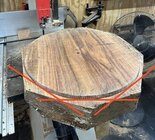I am in the middle of processing green maple bowl blanks but am having a difficult time cutting them in the round with my 18" Jet 1-1/2 HP bandsaw with a 1/" 4 TPI blade. The blade builds up on one side (left) with caked on debris causing the blade to wander. Any thoughts on size of blade or how to keep it clean
-
December 2025 Turning Challenge: Single Tree! (click here for details) -
Congratulations to Bob Henrickson, People's Choice in the November 2025 Turning Challenge (click here for details) -
Congratulations to Guillaume Fontaine for "Old Tea Pot" being selected as Turning of the Week for December 15, 2025 (click here for details) -
Welcome new registering member. Your username must be your real First and Last name (for example: John Doe). "Screen names" and "handles" are not allowed and your registration will be deleted if you don't use your real name. Also, do not use all caps nor all lower case.
You are using an out of date browser. It may not display this or other websites correctly.
You should upgrade or use an alternative browser.
You should upgrade or use an alternative browser.
best bandsaw blade for bowl blanks
- Thread starter Ivan Stancioff
- Start date
Please consider giving up on round and just knock the corners off. Straight cuts are easier on blades.
my 18" Jet 1-1/2 HP bandsaw with a 1/" 4 TPI blade.
What is your blade width? If it's 1", a narrower blade will make a difference. If you meant to type 1/2" then I've got nothing.
1/2 inch 3 tpi Lennox Diemaster. Great for cutting circles. Not as good for cutting slabs though. 4 tpi is a bit too many teeth per inch to get good chip/shaving clearance. 1/2 inch blade cuts circles down to 5 inch diameter no problem.
robo hippy
robo hippy
2 things I do that help, though they don't solve the problem entirely:
1. Spray the blade with a non-stick cooking spray prior to cutting. cheap is fine. It's the inside of the curve that gets most of the gunk, and it might not be necessary to spray the other side. This does cause some gunk to build up in the upper blade guide area.
2. Since some gunk will build up anyway, I take a waste piece of reasonably hard wood and place it against the spinning blade, on the inside/left side of the blade, behind the gullets. This will scrape off fresh, soft gunk, especially if you have used the non-stick spray. I have also simply cut a piece of dry, hard wood, but scraping seems to be more effective.
1. Spray the blade with a non-stick cooking spray prior to cutting. cheap is fine. It's the inside of the curve that gets most of the gunk, and it might not be necessary to spray the other side. This does cause some gunk to build up in the upper blade guide area.
2. Since some gunk will build up anyway, I take a waste piece of reasonably hard wood and place it against the spinning blade, on the inside/left side of the blade, behind the gullets. This will scrape off fresh, soft gunk, especially if you have used the non-stick spray. I have also simply cut a piece of dry, hard wood, but scraping seems to be more effective.
- Joined
- Apr 27, 2004
- Messages
- 9,304
- Likes
- 6,059
- Location
- Lakeland, Florida
- Website
- www.hockenberywoodturning.com
What @Dean Center said.
I use either a 1/2” 4tpi or 3/8 4 tpi.
A dry wood scrap block will knock off the gunk.
I use either a 1/2” 4tpi or 3/8 4 tpi.
A dry wood scrap block will knock off the gunk.
Absolutely! I’ve been saying this for ages. Quite why some folks seem determined to produce perfectly round blanks amazes me. Isn’t that what a lathe is for?Please consider giving up on round and just knock the corners off. Straight cuts are easier on blades.
As for blades I use 3/8” with three or four TPI. But honestly, if I need to cut a blank and there’s a half inch blade on the machine I’ll use that.
If "time is money" to you, then cutting a round saves a lot of time compared to an octagon. A good sharp blade makes cutting circles easy.
robo hippy
robo hippy
Have a Jet 20" bandsaw. I use 1/2" 3tpi blades and cut round most always if able. Have a stack of wood disks in 1/2" sizes for templates. It's a simple process and as Robo mentioned can get down to about 5" dia, especially with a somewhat new blade. Blades are cheap and my last order of 8 blades were about $17 dollars ea. That was many years ago and I have 2 new ones still left.
It's really a simple process once you learn how to twist instead of push.
Ea their own I guess, but for blanks that you are able to cut round, I don't see why you wouldn't, and cut straight, unless your blade is getting dull, losing its set, or getting gummed up. If I find myself starting to have to make straight cuts, that's a clue for me to put a new blade on. There is a knack to efficiently cut round and not gum up your blade so much. Also, I use blades with quite a bit of set. These are bulk blades you buy by the inch, tooth, and set, not blades you buy premade in your local woodworking store.
It's really a simple process once you learn how to twist instead of push.
Ea their own I guess, but for blanks that you are able to cut round, I don't see why you wouldn't, and cut straight, unless your blade is getting dull, losing its set, or getting gummed up. If I find myself starting to have to make straight cuts, that's a clue for me to put a new blade on. There is a knack to efficiently cut round and not gum up your blade so much. Also, I use blades with quite a bit of set. These are bulk blades you buy by the inch, tooth, and set, not blades you buy premade in your local woodworking store.
Last edited:
My typo meant to be "1/2" 4 TPI"
Thanks for all your input and advice. I purchased a 3/8" 3 TPI (Timber Wolf) and attempted to cut 15" diam. rounds of green maple and ash today. Still a tough go. Need to practice the "twist". Also I Found that water will easily remove the gunk off the wheels and blade.
I will try the 1/2" 3 TPI next..
Thanks for all your input and advice. I purchased a 3/8" 3 TPI (Timber Wolf) and attempted to cut 15" diam. rounds of green maple and ash today. Still a tough go. Need to practice the "twist". Also I Found that water will easily remove the gunk off the wheels and blade.
I will try the 1/2" 3 TPI next..
You want the center of your blank roughly in line with the cutting edge of the saw and then try to rotate around that point only as fast as your saw can cut. Anything else leads me to twisting on the blade, which creates lots of unnecessary heat and wear. I have a hard time with that sometimes. I'm not the most patient person.
I used to use Timber wolf blades at first, never got good long term results with them. Not sure what it was, almost as if they didn't have enough set and would dull too fast. My last blades that I got were through a supplier I met at a Logers expo in Upper Michigan. They had all different variations of blade stock and you ordered by your blade length and they would make them for you. They were not only much better than the Timberwolf blades I had been getting, but also cheaper. If I remember right, you had to order at least 6 though.My typo meant to be "1/2" 4 TPI"
Thanks for all your input and advice. I purchased a 3/8" 3 TPI (Timber Wolf) and attempted to cut 15" diam. rounds of green maple and ash today. Still a tough go. Need to practice the "twist". Also I Found that water will easily remove the gunk off the wheels and blade.
I will try the 1/2" 3 TPI next..
I tried a 4 tooth once, was painfully slow at cutting.
If you have experience with a scroll saw, its somewhat of the same principal when cutting curves. You do not want the blade bending sideways when cutting a curve or you will overheat it and pitch it up. If it starts to bend you need to back off, let it catch up, and reassess the direction you are feeding your blank into it vs the actual wanted cut line.
Last edited:
- Joined
- Apr 27, 2004
- Messages
- 9,304
- Likes
- 6,059
- Location
- Lakeland, Florida
- Website
- www.hockenberywoodturning.com
My typo meant to be "1/2" 4 TPI"
Thanks for all your input and advice. I purchased a 3/8" 3 TPI (Timber Wolf) and attempted to cut 15" diam. rounds of green maple and ash today. Still a tough go. Need to practice the "twist". Also I Found that water will easily remove the gunk off the wheels and blade.
I will try the 1/2" 3 TPI next..
I cut blanks using hardboard discs pinned to my my selected center point with a scratch awl.
I learned a useful trick from Liam O’Neil last century.
Liam taught me when making the turn into the engrain to feel for resistance.
If you feel resistance stop the turn and cut straight out then pick up the cut.
That way you don’t fight the endgrain.
On many blanks the turn can be made smoothly.
Just something I’ve found useful.
HelloI am in the middle of processing green maple bowl blanks but am having a difficult time cutting them in the round with my 18" Jet 1-1/2 HP bandsaw with a 1/" 4 TPI blade. The blade builds up on one side (left) with caked on debris causing the blade to wander. Any thoughts on size of blade or how to keep it clean
I use a frow to split the large logs down, it will give you more stable wood and quickly breaks down what you could not do with your bandsaw.
I use a compass/divider to lay out my circles. I do have a good light to see the line when I am cutting. I am one who tried to get the most out of each log section I cut up, so if any 2 bowls are the same size, it is an accident rather than by intent.
robo hippy
robo hippy
I’m in your camp on this one. 18” x 4” green water oak. I took the time to cut off the corners so I could lift the dang thing. Took about 5 minutes to cut round on the saw which is a lot less than what it would take to cut it round on the lathe. Not sure what blade I’m using. I think it’s 3/8”.If "time is money" to you, then cutting a round saves a lot of time compared to an octagon. A good sharp blade makes cutting circles easy.
robo hippy
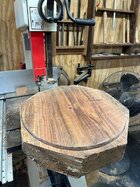
The issue for me is that I use my bandsaw for other stuff, and if you cut round blanks you dull the blade more one side than the other.
This makes the blade useless for straight cuts. I didn’t know this until someone pointed it out. I wondered why I was struggling to make straight cuts.
I could keep one blade for blanks but to be honest I need the turning practice, and keep swapping blades for otherwise quick jobs would be a real PITA.
Years ago many commercial blanks were actually square here in the UK. This was very handy as some larger ones could be a good source for small spindle projects. Sadly virtually all commercial bowl blanks are now round.
This makes the blade useless for straight cuts. I didn’t know this until someone pointed it out. I wondered why I was struggling to make straight cuts.
I could keep one blade for blanks but to be honest I need the turning practice, and keep swapping blades for otherwise quick jobs would be a real PITA.
Years ago many commercial blanks were actually square here in the UK. This was very handy as some larger ones could be a good source for small spindle projects. Sadly virtually all commercial bowl blanks are now round.
I am in the middle of processing green maple bowl blanks but am having a difficult time cutting them in the round with my 18" Jet 1-1/2 HP bandsaw with a 1/" 4 TPI blade. The blade builds up on one side (left) with caked on debris causing the blade to wander. Any thoughts on size of blade or how to keep it clean
Don't know about "best" (there are some variables and preferences to consider). I almost always keep a Lenox 1/2”x3tpi blade on my 18” Rikon, for green wood (including processing log sections) and dry wood, from a local Lenox blade shop. I usually sharpen several times before replacing so dulling the blade on one side is not an issue. A BIGGER issue is incorrect blade tension. The little indicators and pointers on most bandsaws have been proven to be nearly useless. Other popularly promoted methods can be worse since they rely on magically acquired experience. I use a good bandsaw blade tension gauge.
I have no problem in cutting things round, I find it just as quick and easy as to cut, a simple matter of coordinating the cut with constant turning - gets easier with practice. (and by removing more wood the blank might dry a bit tiny bit quicker and may be subject to fewer drying stresses/cracks depending on the specific piece.)
I far prefer to turn dry wood. This blank will probably take years to dry. Not a problem if processing often and you have enough storage space!
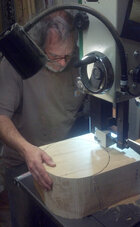
Two things help keep down buildup on the inside of the blade when turning wet wood. One is a powerful dust collector, and another is stiff brushes in constant contact with the bandsaw tires (not the blade). Many bandsaws come with one; a second stiff brush on the other wheel doesn't hurt.
The best thing I've come up with to quickly remove packed-on gunk is to simply scrape the gunk off the side of the blade while it's running. It only takes a few seconds.
This can be perfectly safe - I keep a piece of thinwall brass square tubing, 1/4" or less and maybe 8" long, fastened to a magnet on the column of my bandsaw by means of bit of steel wire at the end. This type of tubing is sold in hobby shops and often in hardware stores.
With the motor running, stand to the side or behind the saw and hold the square tube flat on the table and gently push the end into the side of the blade near the back. It will quickly scrap off all the gunk at that spot. Then slide the tube carefully towards the teeth. I don't contact the front of the teeth, but if that happens no harm done since the brass won't hurt the teeth. Repeat on the other side of the blade in the rarer case that's needed.
This may sound hazardous but it's not (except maybe for the particularly clumsy or easily distracted, who might want to consider a different hobby.) I have several friends now using the same technique. I should take a picture of that little square tube in use.
On most bandsaws the gunk is worse on the inside of the blade where it gets packed by the wheel. (Make sure the guides are not too tight which can make the problem worse.)
The sap junk on a shop bandsaw may build up more quickly when cutting through wet sap wood on some species. Sawing only heartwood is usually not as much of a problem.
I go through spells where I cut up a LOT of green wood.
It's a disease and I may need professional counseling. But it results in plenty of blanks!
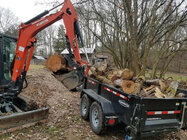
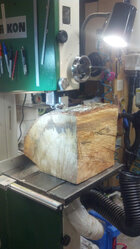
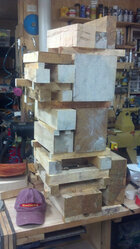
JKJ
One video I did was Bandsaw Dust Ports do not Suck. For sure, they are not made for cutting green wood. I do use that Slick Stick stuff on my blades before cutting Madrone, which does gum up everything. Some times Pam, some times Boeshield, and maybe a few other things. I do not know if I have ever heard that cutting circles makes the teeth dull on one side or maybe even takes the set off of the one side. Can't say I have ever noticed it before. Most of the time my small saw cuts circles only, but when I switch to straight cuts, I have never noticed the blade having problems with following a straight line or a parallel cut to the fence, at least not as long as it is set up correctly in the first place. Maybe this is an advantage for the bimetal blades with the teeth being harder, they cut longer and straighter.
robo hippy
robo hippy
One video I did was Bandsaw Dust Ports do not Suck. For sure, they are not made for cutting green wood.
I had that problem before adding a little box (I think I wrote about this long time ago). The Rikon 18" picks up the stuff that shoots down below the table and leaves almost nothing in the lower cabinet, wet or dry. It's a little box that fits under the table and round the lower guides, made to direct airflow straight across the blade where it's picked up by the angled dust collector port on the side of the lower cabinet. However, the DC is powerful.
I first made a prototype from cardboard that worked so well I used it for a long time before making one from clear plastic (so I could inspect inside easily). Magnets hold it in place.
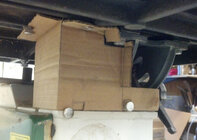
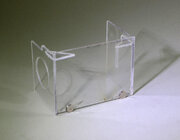
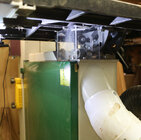
The dust is collected in three places using a 5HP ClearVue cyclone: the angled side port, the port in the bottom cabinet,
and an extra one on a flex hose positioned with a magnet as needed for dust that sprays across the table.
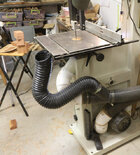
JKJ
I’ve been using a blades from Highland woodworking ,the Woodturners 3/8” x 3TPI works very good on green wood but I use it on dry wood too.
I usually round mine off with the chainsaw after I cut the blank, saves me time. I will occasionally bandsaw a blank if it’s small and use a 3/8-3tpi..
To clean my blade from the gunk build up I use an old wood chisel. Turn it upside down on the table, put it against the blade and rotate the wheel by had and one or two passes the build up is gone, scrapes it right off.

To clean my blade from the gunk build up I use an old wood chisel. Turn it upside down on the table, put it against the blade and rotate the wheel by had and one or two passes the build up is gone, scrapes it right off.

Last edited:
my favorite is Highland Woodworking's "Woodturners Bandsaw blade".
Any blade, use a medium grit diamond hone to round over the 90 degree corners on the back of the blade. With the saw unplugged and the blade tensioned, turn the upper wheel with one hand while holding the hone, braced on the table, against the rear corners of the blade. A full radius is not needed, just relieve the hard angle corners. The left rear corner (from the operator's perspective) especially wants to rub hard into the wood during a circular cut (a turner's typical cut, turners usually don't scroll left and right turns) and it's worse when a blade is cutting near the smallest diameter the blade can cut.
As other stated, I don't shoot for a cylinder with rough blanks. Octagons and similar roundish polygons are fine for me, and easier to cut on the saw.
As other stated, I don't shoot for a cylinder with rough blanks. Octagons and similar roundish polygons are fine for me, and easier to cut on the saw.
Last edited:
I use the woodturners blade from Highland Woodworking as well. Works great on my 14” Jet.
I don't shoot for a cylinder with rough blanks. Octagons and similar roundish polygons are fine for me,
There is at least one reason I cut blanks round. Our club has a wood auction every year and I donate tubs of dry blanks of all kinds and sizes. I like to cut any bowl blanks round. It lets prospective bidders evaluate the color and figure and perhaps bring a better price. Also might eliminate surprises.
For the same reason I generally put bowl blanks and platter blanks through the drum sander, to flatten and make the top/bottom parallel, as well as to better show the wood, any defects. For our last auction I brought a couple of good-sized dry bowl blanks from rough-sawn 10/4 Honduran Mahogany, cut round and sanded. They ended up looking so good I wanted to keep them! (but I can make more)
When I cut up wet logs for blanks for myself, to give away, or dry, I cut them round.
It takes an insignificant amount of extra time.
Fortunately, there is room in woodturning for varying paths, none is the only way.
And while not round, of course, for several reasons I always make dry blanks like this with curved sides smoothed to the template line with the disk sander, flattened top and bottom by drum sanding. Makes turning this design easier, especially for a beginner.
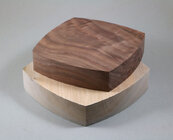
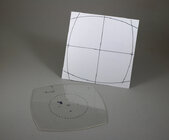
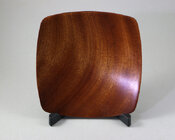
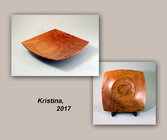
JKJ
Last edited:

